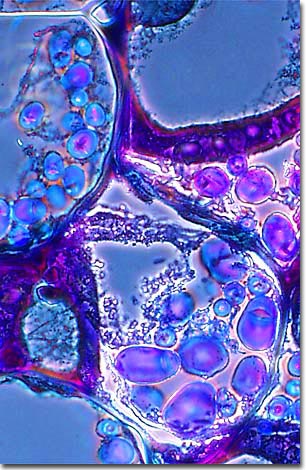Phase Contrast Image Gallery
Potato Blight
Potato late blight, caused by the fungus Phytophthora infestans, is one of the most important potato diseases in the world. It was responsible for the great Irish Potato Famine of the 1840's, leaving over 1 million people dead from famine-related diseases and resulting in the exodus of more than 1.5 million people from Ireland.

Illustrated in the photomicrograph above is a thin section of potato tissue infected with this deadly fungus. The potato plant is a native of South America and has been cultivated by Native Americans for thousands of years. Introduced to Europe by the Spaniards in the mid 1500s, it was probably already carrying milder forms of the late blight fungus. It wasn't until 1844 that the virulent strain (speculated to be a single clonal genotype of P. infestans) arrived in Ostende, Belgium with a shipment of seed potatoes from the United States. Within two years, potato crops in Europe, as well as Ireland, had been largely destroyed.
Disease outbreaks are caused by vegetative reproduction (self-cloning) of the fungus and require cool temperatures and moist conditions. Controlling the fungus is difficult because it has a complicated life cycle with distinct and strikingly different spore forms ranging from motile zoospores (produced by self-cloning) to thick-walled oospores (produced by sexual reproduction).
Late blight continues to be a threat with the emergence of a new strain in the United States during the 1990s. The new strain is virulent and remarkably destructive, devastating apparently healthy potato fields within days. It also reproduces in lower humidity, making it a threat to potato crops in more arid regions.
BACK TO THE PHASE CONTRAST GALLERY
